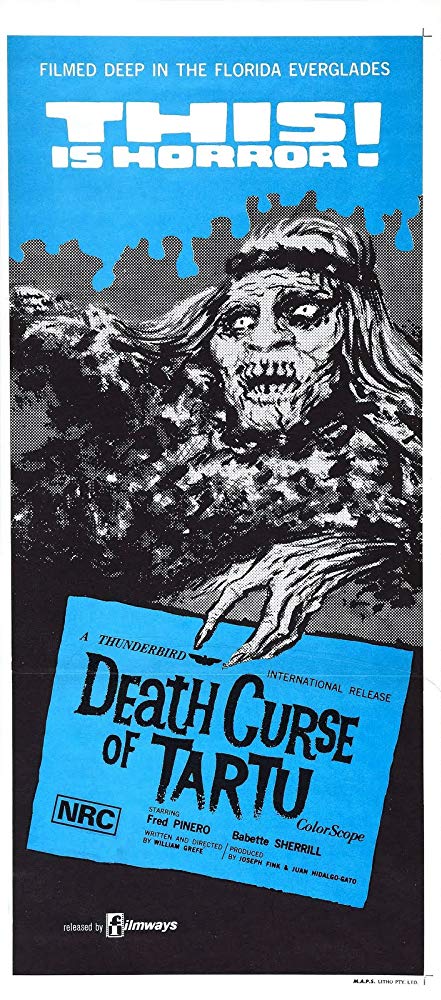
The 1970 film Guru, the Mad Monk opens with a woman being dragged, by two men, down a New York sidewalk. In the background, you can clearly hear the sounds of Manhattan morning traffic as people head to work or school, presumably barely noticing that a movie is being made one block over.
Now, normally, that might not be a problem. In fact, it’s the kind of things that you tend to expect from an independent film made in the early 70s. Cinema verite was all the rage back then and many films from that period would incorporate documentary techniques, shooting on location and making use of actual bystanders and the sound of actual traffic. However, Guru, the Mad Monk is supposed to be taking place on the isolated (and fictional) prison island of Mortavia. Even more importantly, it’s supposed to be taking place in 1480. Now, obviously, all historical films require a certain suspension of disbelief. I mean, we know that no cinematic version of the 15th Century is going to be a 100% accurate and we really should be happy about that because the the 1400s were a pretty disgusting time to be alive. I mean, we don’t need to see people tossing a chamber pot out of their bedroom window in order to accept that a film is taking place in a certain time period. However, what we do need is for there not to be two scenes that feature the sounds of cars driving by the film’s set. One half expects some random person to wander into the shot and hail a taxi.
Guru, the Mad Monk was directed by Andy Milligan, who is a legendary name as far as grindhouse filmmaking is concerned. Milligan was an off-off broadway playwright-turned-exploitation filmmaker who didn’t let a lack of money and/or discernible talent prevent him from directing an estimated 29 films. Milligan’s films are distinguished by angry (if usually incoherent) storylines, flamboyant performances from a stock company made up of local Staten Island actors, cheap gore effects, and poor sound quality. One reason why you especially notice the sound quality is because a typical Milligan film is surprisingly talky. It makes sense when you consider that Milligan developed his artistic vision while working in theater but, as a director, Milligan never seemed to figure out how to break free from the inherent stageyness of his scripts.
And yet, there’s also an odd and, at times, rather dream-like intensity to most of Milligan’s films. Some of that is undoubtedly due to the fact that a typical Milligan film lacks any sort of intentional humor. For instance, Guru features a supporting character named, believe it or not, Igor. And yes, Igor (played by Jack Spencer)) is a hunchback. And typically, you would think any filmmaker including a hunchback named Igor in a horror film made after 1940 would have to be having a little bit of fun with the cliches of the genre. But no, Guru, The Mad Monk was obviously meant to be a very serious film and very much a reflection of the negative worldview that seemed to permeate all of Milligan’s films. Guru, The Mad Monk is a dark film where almost everyone is corrupt and guilty of something and, watching the film, you get the feeling that its darkness is coming straight for Milligan’s heart.

Notice the white scooter in the background as these 15 century clergymen hold a meeting in Guru, The Mad Monk.
As for what the film’s about …. well, that’s hard to say. The plot is rather difficult to follow. Father Guru (played, in flamboyantly evil style, by Neil Flanagan) is the governor of the prison island of Mortavia. (St. Peter’s, an Episcopal Church in Manhattan, stands in for the prison.) Guru is usually quick to execute his prisoners so that his mistress, Lady Olga (Jacqueline Webb), can drink their blood. It’s hard to say whether Lady Olga is supposed to be a real vampire or not. When we first meet her, she just comes across as being a Lady Bathory-type but then there’s another scene where she appear to be wearing fake fangs and declares herself to be the “Soul of Darkness” so who knows for sure?
In between all of the eye gougings and beheadings that one would typically expect to find in a Milligan film, there’s also a love story as jailer Carl (Paul Lieber) falls in love with the latest prisoner, Nadja (Susan Israel). Nadja is due to be executed but Guru agrees to spare her life if Carl will dig up some bodies and sell them to a nearby university. Carl agrees but it soon turns out that he made a mistake trusting Father Guru. It all leads to the expected bloodbath, along with Guru raving about the joys of living a life where “I preach one thing but continue to believe another!”
Clocking in at just 57 minutes, it’s a weird film. Typically, I tend to defend films like this because, regardless of their flaws, they at least represent the director’s unique vision of the world. That’s always been my defense when it’s come to Ed Wood, for instance. But, when it comes to Milligan …. eh. I mean, from a historical perspective, anyone who is interested in classic grindhouse and independent filmmaking has to see at least one Andy Milligan film. And it can be said that you’ll never mistake an Andy Milligan film for anyone else’s. But, at the same time, I have to admit that watching Guru was the longest 57 minutes of my life.
So, no …. unless you’re on some sort of Andy Milligan kick, I don’t really recommend Guru, The Mad Monk.
Sorry, Igor.





 Forget everything you know about vampires!
Forget everything you know about vampires!













